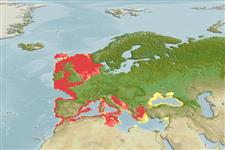>
Gadiformes (Cods) >
Gaidropsaridae (Rocklings)
Etymology: Gaidropsarus: Greek, ga, ge = the earth + Greek, ydro = water + Greek psaros = speckled, starling (Ref. 45335).
More on author: Linnaeus.
Environment: milieu / climate zone / depth range / distribution range
Écologie
marin; saumâtre démersal; océanodrome (Ref. 51243); profondeur 1 - 450 m. Temperate; 5°C - 18°C (Ref. 12468); 62°N - 33°N, 10°W - 42°E
Eastern Atlantic: southern Norway, around the western shores of the British Isles to the southwestern European and northwestern African coasts, and southern European coasts in the Mediterranean Sea, into the Black Sea, .
Taille / Poids / Âge
Maturity: Lm ? range ? - ? cm
Max length : 50.0 cm TL mâle / non sexé; (Ref. 1371)
Épines dorsales (Total) : 0; Épines anales: 0. First dorsal-fin ray followed by a few small fleshy filament. Color varies, brown sometimes reddish and with a vermiculated or mottled pattern dorsally. Paler ventrally. The median fin borders dark (Ref. 1371). One barbel on the lower jaw and two on the snout. Marbled coloration on the back (Ref. 35388).
Lives generally at shallow depths near the shores on rocky bottom with aquatic vegetation to 60 m depth. Feeds on fish, crustaceans, worms and algae. Sold fresh in markets, also made into fish meal (Ref. 1371). Caught as a by-catch by various fishing gears (Ref. 35388).
Life cycle and mating behavior
Maturities | Reproduction | Spawnings | Egg(s) | Fecundities | Larves
Cohen, D.M., T. Inada, T. Iwamoto and N. Scialabba, 1990. FAO species catalogue. Vol. 10. Gadiform fishes of the world (Order Gadiformes). An annotated and illustrated catalogue of cods, hakes, grenadiers and other gadiform fishes known to date. FAO Fish. Synop. 125(10). Rome: FAO. 442 p. (Ref. 1371)
Statut dans la liste rouge de l'IUCN (Ref. 130435)
Menace pour l'homme
Harmless
Utilisations par l'homme
Pêcheries: intérêt commercial mineur
Outils
Articles particuliers
Télécharger en XML
Sources Internet
Estimates based on models
Preferred temperature (Ref.
123201): 7 - 15.2, mean 10.1 °C (based on 505 cells).
Phylogenetic diversity index (Ref.
82804): PD
50 = 0.5001 [Uniqueness, from 0.5 = low to 2.0 = high].
Bayesian length-weight: a=0.00417 (0.00311 - 0.00559), b=3.08 (3.00 - 3.16), in cm total length, based on LWR estimates for this species (Ref.
93245).
Niveau trophique (Ref.
69278): 3.5 ±0.3 se; based on diet studies.
Generation time: 1.8 ( na - na) years. Estimated as median ln(3)/K based on 1
growth studies.
Résilience (Ref.
120179): Haut, temps minimum de doublement de population inférieur à 15 mois (Preliminary K or Fecundity.).
Fishing Vulnerability (Ref.
59153): Low to moderate vulnerability (26 of 100).
Nutrients (Ref.
124155): Calcium = 43.1 [21.4, 94.2] mg/100g; Iron = 0.385 [0.196, 0.772] mg/100g; Protein = 17.7 [15.9, 19.5] %; Omega3 = 0.454 [0.229, 0.848] g/100g; Selenium = 21.4 [9.9, 57.2] μg/100g; VitaminA = 7.13 [1.97, 26.65] μg/100g; Zinc = 0.594 [0.413, 0.895] mg/100g (wet weight);
